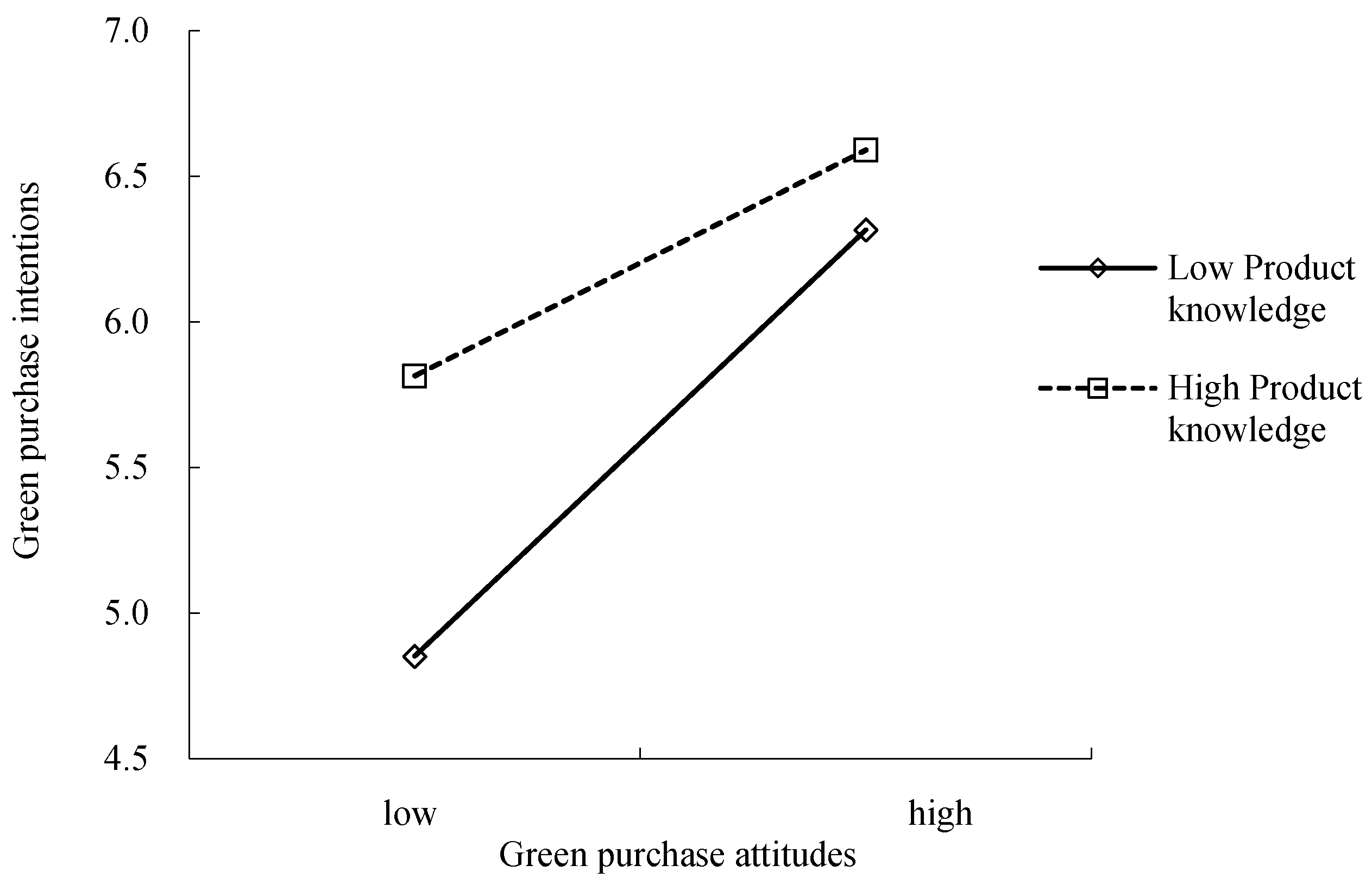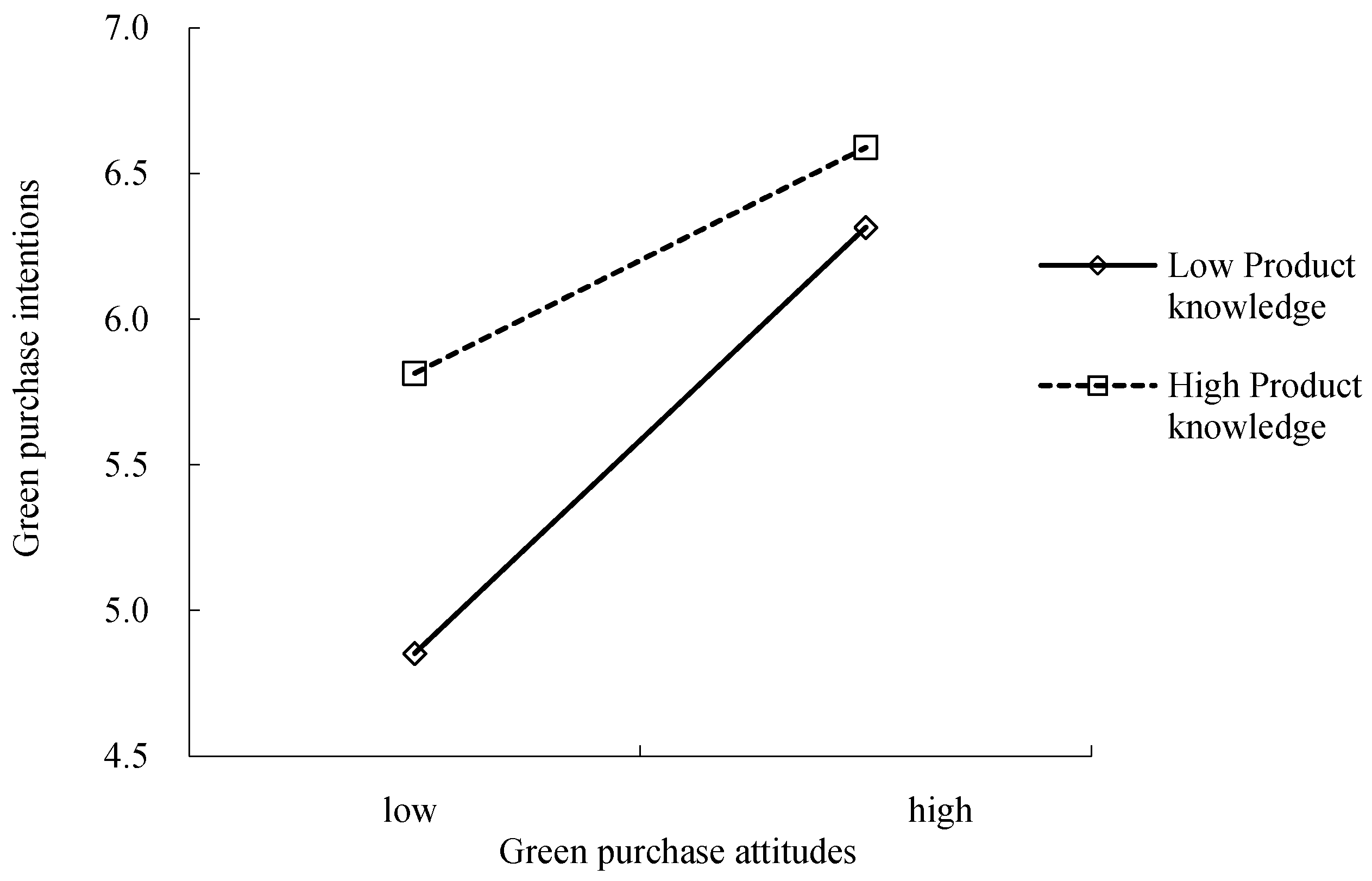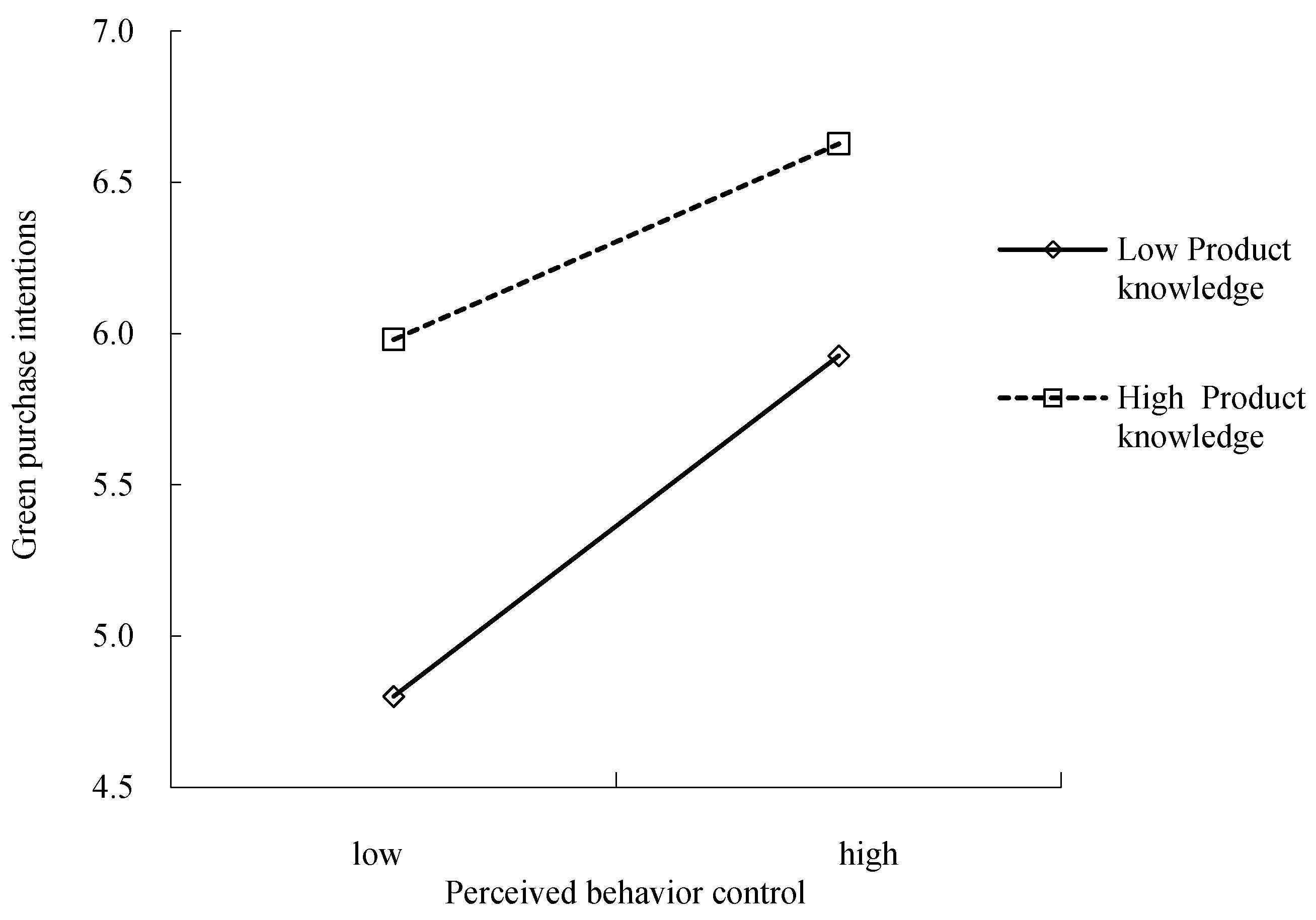3.1. Attitudes, Perceived Behavior Control, Subjective Norms, and Green Purchase Intentions
Most studies suggested that green purchase attitudes would affect the green purchase intentions. The results of Fraj and Martinez showed that environmental attitudes had a significant positive impact on ecological behaviors [
25]. Attitudes would determine a person’s buying preference, and it was one of the most important predictors of green buying behavior [
26]. As an important antecedent, subjective norms were expected to have direct influence on behavioral intentions, and this assumption had been manifested by lots of research [
27]. Collectivist culture in Chinese society results in social norms playing an important role in the purchase decision-making process, and evaluations made by reference group members are key factors affecting consumption choices. Kim and Choi concluded that collectivism had a positive impact on the consumers’ green buying behavior [
5]. Kraft et al. pointed out that perceived behavior control was the confidence for consumers to complete a behavior, and the confidence depended on the perception of their own ability [
28]. Hagger et al. found the positive impact of perceived behavior control on behavior intentions [
29]. We deduced that the same situation would appear again in the field of green buying behavior. Therefore, the study proposed the following hypothesis:
H1: Green purchase attitudes, subjective norms, and perceived behavior control have significant positive impacts on green purchase intentions.
3.2. The Moderating Effects of Product Knowledge
Product knowledge could exert impact on purchase decision making process, because it will enable consumers to have a better understanding of the products and increase rational consideration. Synodinos put forward that increasing consumers’ product knowledge would promote positive attitudes to green purchase intentions [
30]. Chang argued that the spread of information had a positive impact on green purchase intentions [
31]. In the case of more product knowledge, consumers would know traits of green products better, and be inclined to make purchase decisions based on rational thinking rather than feelings. Generally, more product knowledge will lead to stronger green purchase intentions because of better understanding of functional attributes or the price/performance ratio of green products. Therefore, the explanatory power of attitudes would decline. In the case of less product knowledge, consumers making purchase decisions mainly depend on their emotion, thus, the explanation of attitudes would enhance. Therefore, product knowledge would play an important role to moderate the relationship between attitudes and green purchase intentions. Based on the above analysis, this study proposed the following hypothesis:
H2: Product knowledge has a moderating effect between attitudes and green purchase intentions.
Shopping goods are something that customers repeatedly compare the utility, quality, price, and other basic attributes of products before making purchase decisions. So, when consumers consider shopping goods, they will have a higher degree of involvement than when considering convenience goods, which includes seeking information, understanding information, and taking effort to find green products [
32]. In other words, consumers will be more rational and objective in the treatment of product information [
33]. Under this situation, it can be expected that consumers are not likely to refuse to buy green products only because of attitudes bias. As for convenience goods, consumers may pay less attention to product knowledge because of their low-value and frequent purchase. Then it can be expected that consumers would be inclined to accept or refuse green daily products mainly according to their attitudes bias or brand loyalty. Therefore, this study proposed the following hypothesis:
H3: The moderating effect of product knowledge on the relationship between purchase attitudes and green purchase intentions in shopping goods is stronger than that in convenience goods.
Subjective norms reflect the perceived social pressure that individual feels to engage in a target behavior, and are determined by a set of beliefs that relate to culture values. Individualist and collectivist orientations have been found to influence a variety of social behaviors, including green purchase behavior [
7]. In Chinese society, a collectivist culture is the mainstream culture and social outcomes play a role in consumers’ purchase decision-making processes [
20]. If consumers master more product knowledge, they would tend to depend on themselves to make purchase decisions rather than to rely on the decisions made by reference group members. Oppositely, when consumers only master less product knowledge, they have less confidence about themselves and are inclined to imitate other reference group members’ purchase behavior. Thus, the study put forward the following hypothesis:
H4: Product knowledge has a moderating effect between subjective norms and green purchase intentions.
Since shopping goods are more important and more expensive for consumers than convenience goods, consumers will put more effort into the process of purchase decision-making and will put more emphasis on their own interests. In other words, the importance of evaluation that was put forward by other reference group members declines. As to convenience goods, consumers are more likely to engage in green purchase behavior, because they tend to be more cooperative and emphasize group goals over personal ones [
7]. Therefore, we inferred that product knowledge could exert greater effects on the relationship between subjective norms and green purchase intentions in the case of purchase shopping goods. Therefore, this study proposed the following hypothesis:
H5: The moderating effect of product knowledge on the relationship between subjective norms and green purchase intentions in shopping goods is stronger than that in convenience goods.
Good resource conditions can increase the possibility of green consumption behavior and reduce barriers. Individuals who have more product knowledge could better understand the value of green products, and are more likely to take efforts to adopt green purchase behaviors [
34]. In contrast, individuals with less product knowledge are not familiar with green products and lack motivation to overcome barriers [
35]. In other words, once facing lower perceived behavior control, those consumers would think of a lot of negative effects of green purchase behavior, such as wasting their energy or money. Therefore, in the case of more product knowledge, the predictive power of perceived behavior control would decline, and the opposite situation would happen in the case of less product knowledge. Based on the above analysis, this study proposed the following hypothesis:
H6: Product knowledge has a moderating effect between perceived behavior control and green purchase intentions.
Convenience goods are often required and do not need to spend a lot of time, money, and energy to buy. Therefore, consumers have relatively low purchase involvement and do not pay much attention to product knowledge of convenience products. When consumers have more product knowledge, they have more motivation to take efforts to implement green purchase behaviors, especially facing shopping goods. As to convenience goods, consumers are not cautious about making an accurate judgment about functional attributes of products [
36], and are more likely to refuse to buy green products because of time, money, and other limitations which affect the perceived behavior control. Based on this, the following assumptions were put forward:
H7: The moderating effect of product knowledge on the relationship between perceived behavior control and green purchase intentions in shopping goods is stronger than that in convenience goods.










